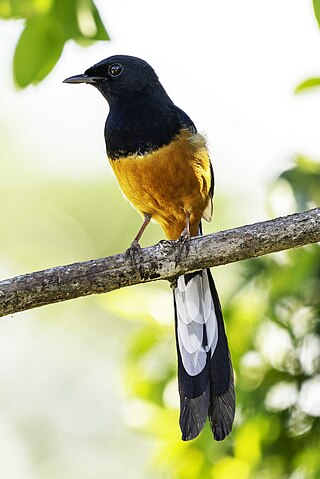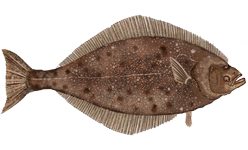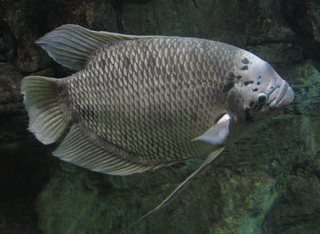
Tetraodontidae is a family of primarily marine and estuarine fish of the order Tetraodontiformes. The family includes many familiar species variously called pufferfish, puffers, balloonfish, blowfish, blowers, blowies, bubblefish, globefish, swellfish, toadfish, toadies, toadle, honey toads, sugar toads, and sea squab. They are morphologically similar to the closely related porcupinefish, which have large external spines. The scientific name refers to the four large teeth, fused into an upper and lower plate, which are used for crushing the hard shells of crustaceans and mollusks, their natural prey.

Clownfish or anemonefish are fishes from the subfamily Amphiprioninae in the family Pomacentridae. Thirty species of clownfish are recognized: one in the genus Premnas, while the remaining are in the genus Amphiprion. In the wild, they all form symbiotic mutualisms with sea anemones. Depending on the species, anemonefish are overall yellow, orange, or a reddish or blackish color, and many show white bars or patches. The largest can reach a length of 17 cm, while the smallest barely achieve 7–8 cm.

The water rail is a bird of the rail family which breeds in well-vegetated wetlands across Europe, Asia and North Africa. Northern and eastern populations are migratory, but this species is a permanent resident in the warmer parts of its breeding range. The adult is 23–28 cm (9–11 in) long, and, like other rails, has a body that is flattened laterally, allowing it easier passage through the reed beds it inhabits. It has mainly brown upperparts and blue-grey underparts, black barring on the flanks, long toes, a short tail and a long reddish bill. Immature birds are generally similar in appearance to the adults, but the blue-grey in the plumage is replaced by buff. The downy chicks are black, as with all rails. The former subspecies R. indicus, has distinctive markings and a call that is very different from the pig-like squeal of the western races, and is now usually split as a separate species, the brown-cheeked rail.

Kurtus is a genus of percomorph fishes, called the nurseryfishes, forehead brooders, or incubator fish, native to fresh, brackish and coastal marine waters ranging from India, through southeast Asia to New Guinea and northern Australia. Kurtus is currently the only known genus in the family Kurtidae, one of two families in the order Kurtiformes. They are famous for carrying their egg clusters on hooks protruding from the forehead (supraoccipital) of the males, although this only has been documented in K. gulliveri and available evidence strongly suggests this is not done by K. indicus. Females do not have a hook.

The red-wattled lapwing is an Asian lapwing or large plover, a wader in the family Charadriidae. Like other lapwings they are ground birds that are incapable of perching. Their characteristic loud alarm calls are indicators of human or animal movements and the sounds have been variously rendered as did he do it or pity to do it leading to the colloquial name of did-he-do-it bird. Usually seen in pairs or small groups not far from water, they sometimes form large aggregations in the non-breeding season (winter). They nest in a ground scrape laying three to four camouflaged eggs. Adults near the nest fly around, diving at potential predators while calling noisily. The cryptically patterned chicks hatch and immediately follow their parents to feed, hiding by lying low on the ground or in the grass when threatened.

The bronze-winged jacana is a wader in the family Jacanidae. It is found across South and Southeast Asia and is the sole species in the genus Metopidius. Like other jacanas it forages on lilies and other floating aquatic vegetation, the long feet spreading out its weight and preventing sinking. The sexes are alike but females are slightly larger and are polyandrous, maintaining a harem of males during the breeding season in the monsoon rains. Males maintain territories, with one male in the harem chosen to incubate the eggs and take care of the young. When threatened, young chicks may be carried to safety by the male under his wings.

Macrobrachium rosenbergii, also known as the giant river prawn or giant freshwater prawn, is a commercially important species of palaemonid freshwater prawn. It is found throughout the tropical and subtropical areas of the Indo-Pacific region, from India to Southeast Asia and Northern Australia. The giant freshwater prawn has also been introduced to parts of Africa, Thailand, China, Japan, New Zealand, the Americas, and the Caribbean. It is one of the biggest freshwater prawns in the world, and is widely cultivated in several countries for food. While M. rosenbergii is considered a freshwater species, the larval stage of the animal depends on brackish water. Once the individual shrimp has grown beyond the planktonic stage and becomes a juvenile, it lives entirely in fresh water.

The white-rumped shama is a small passerine bird of the family Muscicapidae. Native to densely vegetated habitats in the Indian subcontinent and Southeast Asia, its popularity as a cage-bird and songster has led to it being introduced elsewhere.

Hippoglossus stenolepis, the Pacific halibut, is a species of righteye flounder. This very large species of flatfish is native to the North Pacific and is fished by commercial fisheries, sport fishers, and subsistence fishers.

The mangrove monitor, mangrove goanna, or Western Pacific monitor lizard is a member of the monitor lizard family with a large distribution from northern Australia and New Guinea to the Moluccas and Solomon Islands. It grows to lengths of 3.5 to 4 ft.

The Anabantoidei are a suborder of anabantiform ray-finned freshwater fish distinguished by their possession of a lung-like labyrinth organ, which enables them to breathe air. The fish in the Anabantoidei suborder are known as anabantoids or labyrinth fish, or colloquially as gouramies. Some labyrinth fish are important food fish, and many others, such as the Siamese fighting fish and paradise fish, are popular as aquarium fish.

Lethocerus indicus is a giant water bug in the family Belostomatidae, native to South and Southeast Asia, as well as southeast China, the Ryukyu Islands, and New Guinea. It was originally described as Belostoma indicum but is no longer placed in that genus.

The spadenose shark is a species of requiem shark in the family Carcharhinidae. It is common in the tropical Indian and western Pacific Oceans, where it forms large schools in shallow water. A small shark reaching a length of 74 cm (29 in), the spadenose shark is named for its distinctively flattened, triangular snout. It is a predator of small bony fishes and invertebrates. This species exhibits the most advanced mode of viviparity of any fish, in which the developed embryos form a highly complex placental connection to the mother at a very small size. Females breed year-round, giving birth to six to 18 pups after a gestation period of 5–6 months. The spadenose shark is harmless to humans and is valued by artisanal and commercial fishers for its meat and fins. Its abundance ensures it forms a significant component of many fisheries in South and Southeast Asia. The International Union for Conservation of Nature has assessed this species as Near threatened. This fish is also known as mori in Goa

The cloudy catshark is a common species of catshark, belonging to the family Scyliorhinidae. It is a bottom-dweller that inhabits rocky reefs in the northwestern Pacific Ocean, from the shore to a depth of 320 m (1,050 ft). Growing up to 50 cm (20 in) long, this small, slim shark has a narrow head with a short blunt snout, no grooves between the nostrils and mouth, and furrows on the lower but not the upper jaw. It is also characterized by extremely rough skin and coloration consisting of a series of dark brown saddles along its back and tail, along with various darker and lighter spots in larger individuals.

The flat-faced seahorse, longnose seahorse, low-crowned seahorse or three-spot seahorse is a species of fish in the family Syngnathidae. It is found in Australia, Cocos (Keeling) Islands, French Polynesia, Hong Kong, India, Indonesia, Japan, the Philippines, Singapore, Taiwan, Thailand, and Vietnam. Its natural habitat is shallow seas. It is threatened by habitat loss.

Taeniamia zosterophora, the girdled cardinalfish, is a species of cardinalfish native to the western Pacific Ocean from Indonesia to Vanuatu and from the Ryukyus to Australia. It is in the genus Taeniamia, which was described in 2013. This species can be found on reefs in protected bays and lagoons, occurring in dense schools around and among the branches of various species of branching corals, notably Porites cylindrica and species of Acropora and over sandy patches. It is found at depths from 1 to 40 m. This species can reach a total length of 8 cm (3.1 in). It can be distinguished by two narrow vertical red stripes next to its gills and by a distinct small black dot at the base of its tail. It occasionallyis found in the aquarium trade.

Taeniamia is a genus of cardinalfishes native to the Indian Ocean and the western Pacific Ocean.
Kurtus gulliveri, the nurseryfish, is a species of fish in the family Kurtidae native to fresh and brackish waters in southern New Guinea and northern Australia. They can be found in estuaries, mangrove swamps, nipa swamps and slow-flowing rivers with high turbidity. This species can reach a length of 63 cm (25 in), although most are far smaller: In a study of its morphology, 159 specimens were examined and the largest was 33 cm (13 in), while the average was 14 cm (5.5 in). This species is famous for its unusual breeding strategy where the male carries the egg cluster on a hook protruding from the forehead (supraoccipital). Females do not have a hook. It feeds on crustaceans, small fish and insect larvae. This species is well regarded as food. The specific name honours a "Mr Gulliver" who collected the type, thought most likely to refer to Thomas Allen Gulliver (1847-1931) who worked on Australia's a post and telegraph services and who lived near the Norman River, Gulf of Carpentaria where he collected natural history specimens and where the type of this species was collected.

The giant gourami is a species of large gourami native to freshwater habitats in Southeast Asia. It has also been introduced elsewhere. The species is commercially important as a food fish and is also farmed. It can be found in the aquarium trade, as well. The species has been used for weed control on highly invasive aquatic plants like Salvinia molesta, as the giant gourami can be a voracious herbivore.

The Kurtiformes consist of two extant families of ray-finned fish, the Indo-Pacific Kurtidae and the much more diverse and widespread Apogonidae. The order is part of the Percomorpha clade and is regarded by many authorities as a sister taxon to the Gobiiformes.



















